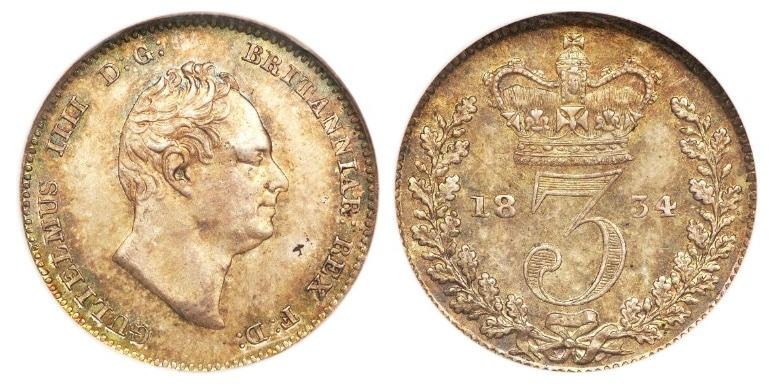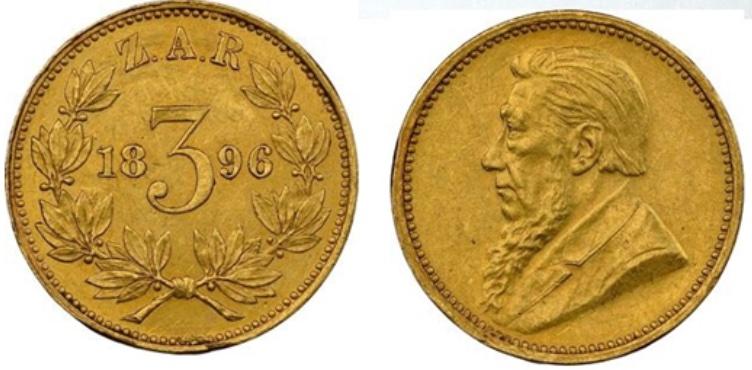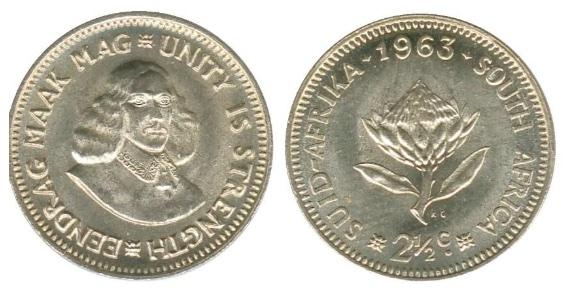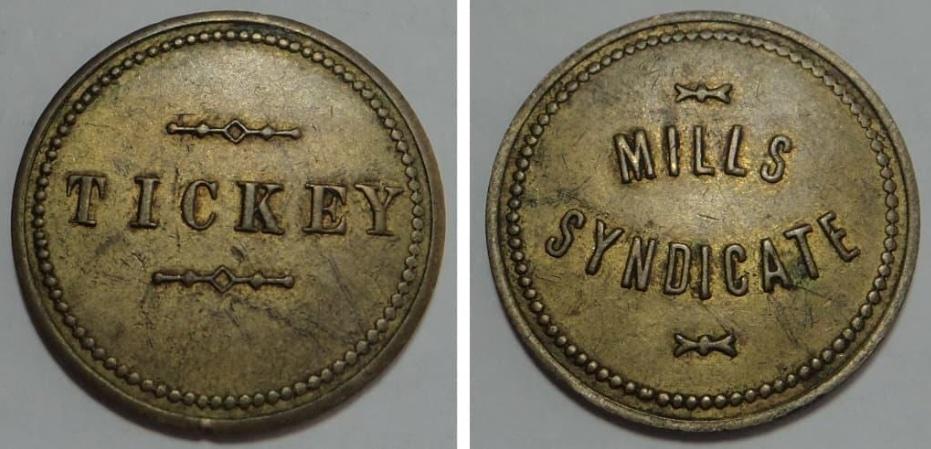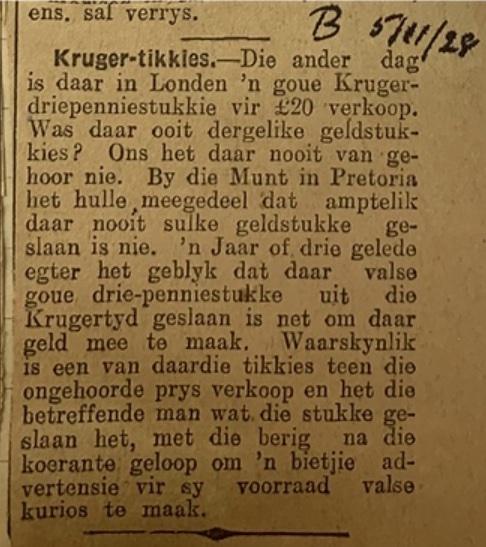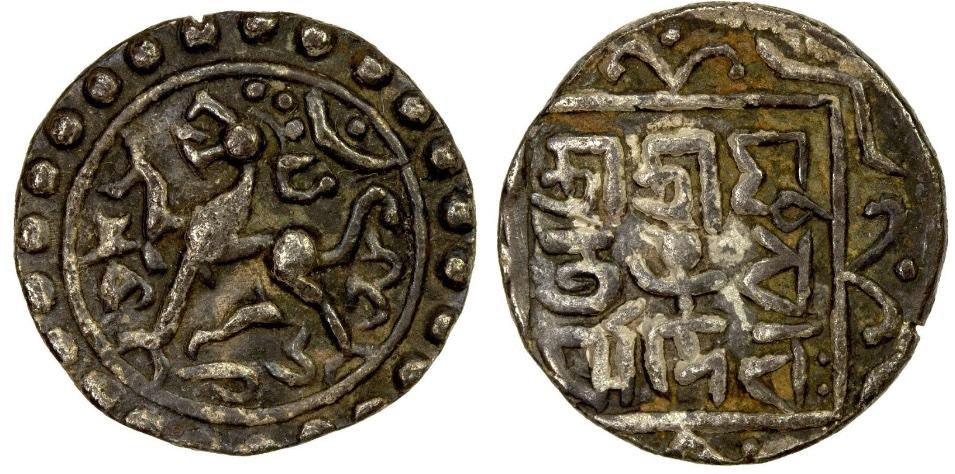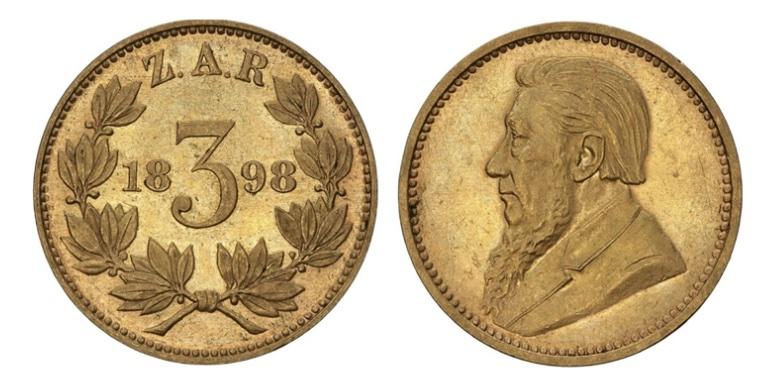
Disclaimer: Any views expressed by individuals and organisations are their own and do not in any way represent the views of The Heritage Portal. If you find any mistakes or historical inaccuracies, please contact the editor.
The word “tickey” was a slang name given to the lowest denomination coin issued in silver for use in South Africa in pre-decimal times during the 1800s and 1900s. It was equal to three pennies and also called a threepence or thruppence. The last of these were struck in 1960 when South Africa’s coinage was decimalized. However, for the next four years, silver 2½ cent pieces, also called tickeys, were struck until 1964 when our second decimal coin series was introduced the next year. Thirty-three years later, in 1997, the tickey (2½ cent) was reintroduced by the South African Mint as a commemorative series struck for collectors.
The word “tickey” gained legendary numismatic status, even internationally, due to South African coins like the gold Sammy Marks tickey struck in the late 1800s and the Union of South Africa’s 1931 issue, both very scarce issues.
Origin of the name
The Dictionary of South African English (DSAE) gives various possibilities where the word “tickey” came from, but it is clear that there is no consensus on this. Past writers suggested that it came from Portuguese pataca a colonial coin, or French patac ‘small coin’ (via the French Huguenots). Others suggest that the Malay word “tiga” (three) was its origin.
DSAE notes that both Xhosa and Zulu use itiki for the coin, described by lexicographers as being borrowed from South African English, but it is possible that itiki was in fact a rendering in the Nguni languages of a Dutch or English word, such as Dutch stukje ‘little bit’, or English ticket or even threepence (i-tiki-peni becoming u-no-tiki and then itiki).
M.D.W. Jeffreys, in ‘Tickey: Origin of the Word’ (Africana Notes & News, Vol.10) refers to Portuguese Angola, where the universal currency, a brass rod worth about 3d., was known as ntaku, but decides upon the Hindu taka (a stamped silver coin) as the origin of itiki in the Nguni languages of the east coast (whence it came into South African English usage).
Elwyn Jenkins (2006) wrote that despite its disputed etymology, South African English-speakers in the olden days were proud of the word and enjoyed puzzling visitors with it; to them it was one of a small number of strange words current in their English that were essentially South African.
The introduction of the three pence in South Africa
The three pence coin, expressed in writing as "3d", first appeared in England during the reign of King Edward IV (1547–53). When the Dutch settled at the Cape in 1652, silver coins of virtually all nations were welcomed locally as hard specie was scarce. During that period, King Charles II reigned Great Britain and three pences were struck during his reign from 1670 until 1684. These coins were probably known at the Cape but it is questionable if they circulated in large numbers.
With the first British occupation of the Cape in 1795, King George III was on the throne and three pences were struck during his reign from 1762 to 1800. Although the British relinquished the colony to the Dutch in the Treaty of Amiens (1802), they re-annexed it in 1806 after the start of the Napoleonic Wars.
During this period, Great Britain’s silver coin production virtually ceased until 1816 with the so-called “Great Recoinage”, when a massive coinage program was undertaken to help stabilize the United Kingdom's finances following the Napoleonic War.
However, for some reason, three pences were not struck for circulation until the reign of King William IV when they were issued from 1834 onwards in the colonies. We can safely presume that the word “tickey” was only coined after this date in Southern Africa (the word was also used in Rhodesia, currently named Zimbabwe).
King William IV 3d of 1834 (Numista)
Earlier use of the word
The first recorded use of the word, as far as we could find was in 1855, when according to DSAE a certain R.J. Mullins wrote in his or her diary that the local black people “… do not understand the value of anything except 3d. bits. It is very expensive work, for they will take nothing below ‘Tick’, as they call it, whereas some time ago they wanted 1d. for everything because it was ‘inkulu’ (large) money.”
By the 1870s, the word was established in the Northern and Eastern Cape as well as the Transvaal, as shown in the following examples.
In 1872 C.A. Payton wrote in the Diamond Diggings (In Kimberley in the Northern Cape): “Coppers are altogether unknown on the diggings; the three-penny-piece, known as the ‘ticky’ is still in currency, but there is a considerable scarcity of these small coins”.
In 1876, Surgeon General A. Graham Young, on a visit to the Eastern Cape wrote how the Xhosas used to beg for tobacco and money: “… give tobacco; and if they receive a negative in reply they are not at all abashed, but continue with ‘N’isela tickey,’ Give me a threepenny-bit. Even the chiefs condescend to beg most importunately and persuasively for tickeys”.
In 1879 L. Hutchinson wrote in In Tents in the Transvaal that “Threepenny bits are the lowest coins [...] they are in great request among the blacks who call them ticcys”.
Later use of the word
In Afrikaans, the word "tiekie" (usually meaning small) has given rise to compounds such as tiekiedraai (a folk dance), tiekieboks (telephone booth) and langtiekie (a kind of illegal use of the pay phone) as well as the expressions "a car that can turn on a tiekie". Eric Hoyland, a beloved circus dwarf in South Africa over several decades in the 20th century, had the stage name Tiekie (Tickey). In English the Ficus pumila, commonly known as the creeping fig or climbing fig is known as the Tickey Creeper in South Africa, probably due to its small leaves.
Three pences used in South Africa
As we have shown before in this paper, the three pence as a circulating coin was probably known at the Cape since the times of the East India Company (VOC). However, we believe the denomination only became widely used almost 200 years later.
Of importance here is the fact that it was only twenty years after the second occupation of the Cape in 1806, that the British government decided to put the currency of all its colonies on a sterling basis and on 1 January 1826, British coinage was introduced as the official currency of the Cape Colony consisting of the ¼d, ½d, 1d, 6d, 1/-, 2/6, 5/-, 10/- and £1. The 3d however, as we have stated, was only struck 8 years later.
Threepences used locally were struck during the reigns of William IV (up to 1837) Queen Victoria (1838 to 1902) King Edward VII (1903-1910) and King George V from 1911.
Paul Kruger’s Zuid-Afrikaansche Republiek (ZAR) struck silver threepence bearing his effigy from 1892 until 1897. Gold specimens were struck bearing the dates 1894 (rumored that only 2 or 3 exist), 1898 (of which 215 were struck) and 1896, last mentioned unique and only recently discovered and then certified by NGC – see picture below.
Gold 1896 ZAR Threepence (Thomas van der Spuy)
The Union of South Africa started striking coins in 1923 (including the threepence) and continued up to 1960, when our first decimal coinage was introduced. During the first three years, the tickey was struck with a wreath reverse that was changed in 1925 showing a Protea. The 1925 issues were struck with either the wreath or the Protea, the former scarcer than the latter.
1925 issues (Pierre Nortje)
Silver 2½c pieces were struck from 1961 to 1964 showing Jan van Riebeeck on the obverse and the Protea on the reverse similar to the pre-decimal issues but with the bundles of sticks removed. From 1997 onwards, commemorative proof specimens were issued for collectors.
2½c pieces struck from 1961 to 1964
Tickey Tokens
The threepence was also struck as token coinage in South Africa during the late 1800s and early 1900s. This example of the Mills Syndicate, Cape Town, shown below, is the only one that we are aware of that the word “tickey” is actually depicted and not “3d”. It was struck in 1899. The syndicate was property developers also involved in tram lines in the Cape.
Tickey Token (Pierre Nortje)
Some last thoughts
As we have shown earlier in this paper, the origin of the word tickey is not certain. The following is speculation by the author...
We are fairly certain that the word is not of English origin, but could have entered South African English locally via Afrikaans spoken at the Cape in the 1830s and 1840s by the brown and white population.
As most Afrikaans words are of Dutch origin, let us look at the word “tikkeltje” whose synonym is “beetje” that the Dutch Van Dale dictionary describes as a “kleine hoeveelheid” (small amount) and “klein stukje” (small piece). In Afrikaans the word for “tikkeltje” would be either “titseltjie” (as in a pinch of salt) or “tikkie” (‘n tikkie liefde = a touch of love) and the word “beetjje” would translate to “bietjie” (a little bit).
We know that the word “tiekie” in Afrikaans is the synonym for “tickey” and was used in the old days to indicate something small e.g. the turn a car could make or a circus dwarf. As the English word tickey is derived from the Afrikaans word tiekie, why was the latter not rather spelled “tikkie” (a little bit)?
The answer is that it sometimes was as is shown in this article in the Afrikaans daily newspaper, Die Burger of 5 November 1928.
Here is the translation:
The other day in London a gold Kruger threepence piece was sold for £20. Were there ever such coin pieces? We have never heard of it. The Mint in Pretoria informed us that officially such coins were never struck. A year or three ago some fake gold threepence pieces were struck from the Kruger period only to make money from them. Probably one of these Tickeys was sold at this unheard-of price and the man who struck them then reported it to the newspapers to advertise his stock of fake curios.
The word “tikkie” (not tiekie) is used twice showing that it was not a typo.
In a study of the life of the Afrikaans poet Eugene Marais (1871 - 1936) by FGM du Toit (1940:246) he mentioned that Marais spelled the word tiekie as tikkie.
It looks like the Afrikaans words tiekie and tikkie were used interchangeably up to the 1920s, but the author tried to find the use of either word during the 1800s in South Africa. We know the word tickey in English was well established in Victorian times locally, but if it came from the Afrikaans words tiekie or tikkie then those words must be recorded in old Afrikaans literature from the period indicating threepence pieces.
What we thought would be an easy search proved to be an exceedingly difficult task, actually impossible. We simply could not find one single reference to the word tiekie being used before 1900 although the word tikkie was used as early as 1893. (These references were found due to a competition held by the Western Cape Numismatic Society in February 2024).
The only slang word we could find in Afrikaans dating earlier was trippens, a word derived from the English threepence/thruppence.
We are now virtually certain that the word tickey was not derived from either Afrikaans or Dutch, but most probably the Nguni languages (e.g. Zulu and Xhosa) as originally suggested by M.D.W. Jeffreys. He was of the opinion that the word was taken from the Hindu taka (a stamped silver coin). We know that when the 3-pence coin was introduced in South Africa in the 1830s, Englishmen were already trading in Natal. The Zulus, on the other hand were then already trading with foreign powers, (including the East) for many years at centres like Lourenco Marques in Mozambique.
(According to mintageworld.com, “…the word “taka” is derived from the Sanskrit “tanka” which was an ancient denomination of silver coin. The word taka in Bangla is also commonly used generically to mean any money, currency, or notes. The “Indian rupee” is also called “taka” in North India especially in the states of West Bengal and Tripura”.)
A silver quarter taka from India issued in the first half of the 1700s. (E.E.C.)
However, we do not believe that even as late as the 1830s, the local Nguni accepted coins as currency in the eastern parts of Southern Africa, although the word “Taka” might have entered their language by then. We speculate that it was only from the mid-1850s onwards that coins were accepted (circulated) by these communities and the word was starting to be used and entered the English and Afrikaans languages. It then spread southwards to the Cape and not vice versa.
Main image: Gold Sammy Marks tickey (WCNS)
Pierre Nortje is the secretary of the Western Cape Numismatic Society
Comments will load below. If for any reason none appear click here for some troubleshooting tips. If you would like to post a comment and need instructions click here.

